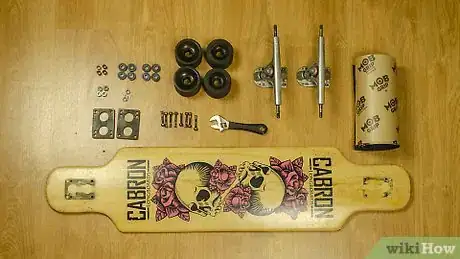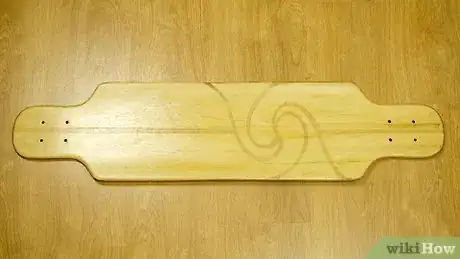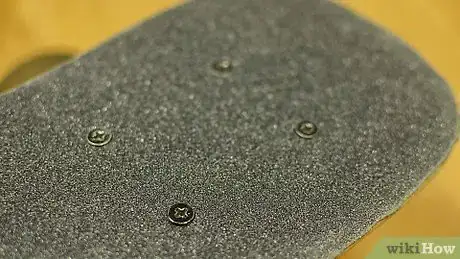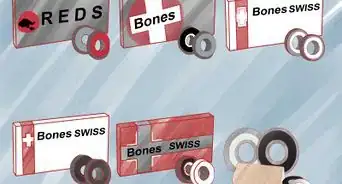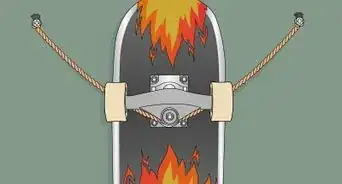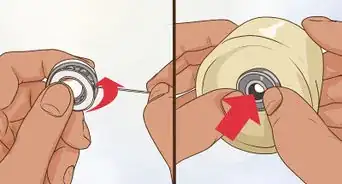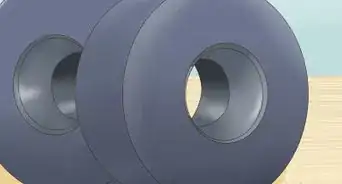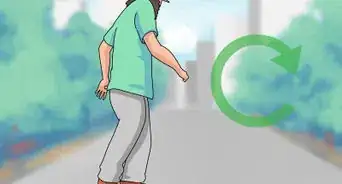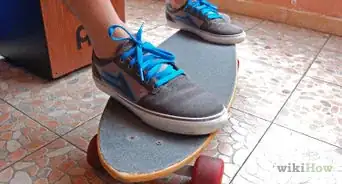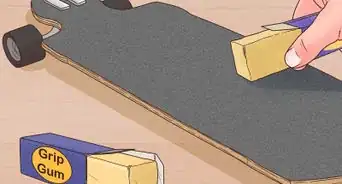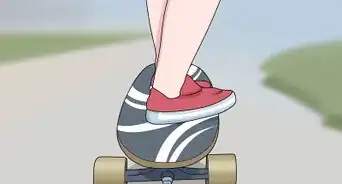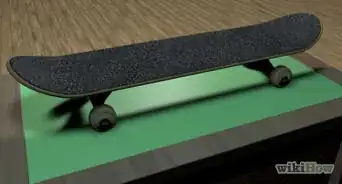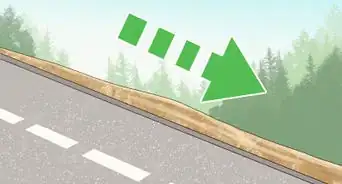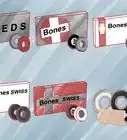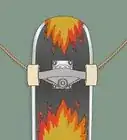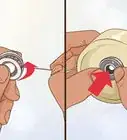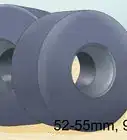This article was co-authored by Jon Depoian. Jon Depoian is a Skateboarding Instructor and the Owner of Intro2Skateboarding, an organization based in Orange County, California that provides professional private, home-school, after-school, birthday party, and summer camp skateboard lessons for beginners and experienced skateboarders alike. Jon has over 21 years of skateboarding experience and over 10 years of skateboard instruction experience. He also has extensive experience producing street skateboarding videos and skating competitions.
This article has been viewed 100,652 times.
If you ordered a skateboard online or purchased parts and need to assemble the board, you can easily do so with a few tools. Assembling your skateboard isn't difficult once you understand how all the parts work together. Start by applying the grip tape to the deck, then screw in your trucks, and finally add the wheels and bearings.
Steps
Applying the Grip Tape to Your Deck
-
1Keep all your parts organized. You will have a lot of small hardware that comes in your skateboard kit. It’s best to keep everything organized so you don’t lose any parts or hardware.
- You may want to keep your parts in the box or original packaging until each one is needed.
-
2Place your deck down on a flat surface. To best apply the grip tape to your deck you want to have it laying flat on an open surface. This will allow you evenly lay the grip tape over your deck.
- You want the nose and tail ends of your board to be pointing up with the graphic on the bottom of the deck facing your flat surface.
Advertisement -
3Place your grip tape over the deck. Your grip tape will be a rectangular sheet that covers a larger area than your board. This allows you a little wiggle room if you don’t place the tape exactly square. Peel the back paper off from the back of your grip tape, like a sticker. Lay the grip over the top of the deck as evenly as possible.[1]
- Be careful to touch as little of the adhesive side of grip tape as possible.
- Pinch the ends of tape between your forefinger and thumb. Pulling the ends of the tape taut, find the edges of your deck with your middle finger and let the grip fall flat onto the deck.
- If you have a piece of grip tape that has a cutout or graphic that is supposed to be on one end of your board, you can identify the nose and tail ends. The tail typically has a steeper incline whereas the nose has a more narrow curve.
-
4Smooth out the grip tape with the palms of your hands. Press down hard to remove any air bubbles. Start at the center of your deck and gradually move outward toward the nose and tail.[2]
- Do your best to make sure there are no air bubbles, as these will dramatically reduce the amount of time the grip tape remains adhesive on the board. Air bubbles also allow small rocks to get between your grip and the deck which can be uncomfortable while riding.
- Take a screwdriver and rub it along the edge of the board to make an outline. You will see a white guideline for cutting.
-
5Trim away the excess grip tape. Cut around the edge with a sharp blade, preferably a razor or box cutter. It’s easiest to start in the center of your deck rather than on one of the edges.
- Make an incision which is perpendicular to your deck. This will make it easier to start cutting and get a consistent cut around your deck.
- Angle your razor over the top of your deck to help the process. Pull the outer portion of your tape to make the cutting easier.
-
6Sand down the edges of the grip tape. Take a portion of the tape that was cut away and, like with sandpaper, rub the edges of your grip tape.
- By sanding the edges you are smoothing out any rough or lifted portions that could peel up.
Putting the Trucks and Wheels on Your Deck
-
1Attach your trucks to your deck. Take a screwdriver or Allen wrench and poke holes through the grip tape. Poke your holes downward so that the grip tape doesn’t crack and your hardware can screw in over the grip. Then place your screws through the holes in the deck. Once your screws are in place, attach your trucks onto your board.[3]
- Attach one truck at a time. Some hardware kits come with multiple colored screws. These different colored screws help you to differentiate the nose from the tail when riding. You can place these screws at either end. Just remember which end you place the screws.
- Use your fingers or the palm of one hand to hold the hardware in place while you attach the trucks. The baseplate is the flat square portion of your truck that connects to your deck. The hanger, the “T” shaped part of your trucks will be facing down. Screw the nuts on over the trucks using your skate tool or socket wrench. You can also use a screwdriver to tighten the heads of the screws.
- Make sure that the kingpins on both trucks, the portion of your trucks with the large nut and rubber bushings, are facing each other. Otherwise, your board won’t ride properly.
-
2Insert your bearings into your wheels. If you don’t have a bearing press, you can insert your bearings using your trucks. Remove the nut and washer from the axle of your truck so you can slide the bearing and wheel on. Most bearings have a flat side and a ridged side. Slide the bearing down onto the axle so the flat side is facing up. Press your wheel down over the bearing until you feel the bearing slide into the center of your wheel. Take the wheel off the axle, slide another bearing down and repeat with the other side of the wheel. Each wheel has two bearings.[4]
- Do this for all four wheels.
- You may hear a popping sound when you press the wheel onto the bearing. This sound indicates that the bearing is fully in.
-
3Attach your wheels. Some wheels have an outside and inside edge. If this is the case, the outside will be the side with the graphic. Some wheels, however, will have graphics on both sides and it doesn't matter which way the wheel goes on the truck. Slide the wheel down onto the axle and then place the washer and nut over the wheel. With your skate tool or wrench, tighten the nut as far as it will go. By tightening the nut all the way you will ensure that your bearings are fully in place. Then loosen the nut enough so that your wheel can spin freely.[5]
- Loosen the nut just a few turns to keep it secure while giving your wheel enough space to move.
- Grab your wheel and tug on it. It should move back and forth on the axle slightly.
- Make sure that your wheel is also level. If it lays at an angle, your bearings are not fully in.
Testing Your Skateboard
-
1Make sure that your grip tape and screws are even. The heads of your screws should be flush with your grip tape. If your screw heads are sticking out, then it will make it harder to perform tricks and maneuver.
- If your screws aren’t flush, screw each one further down. Don’t go too far so as to risk cracking the wood of the deck.
-
2Test your trucks. Make sure that your trucks are firmly secured to your deck. The baseplate portion of your trucks which is attached to the deck shouldn’t move at all.[6]
- If your trucks are loose then you will have a much harder time riding your board, and it could be dangerous if you aren’t an experienced skater.
- If your trucks are too tight, you’ll have a hard time turning your board.[7]
-
3Stand on your board and test it. Rock back and forth and skate around. Test the tightness of your trucks and make sure that your wheels can spin freely.[8]
- If the board feels wobbly, tighten the nut on the kingpin clockwise about half a turn for each truck.
- If your trucks are too tight, you may have trouble turning or carving. Turn the nut of your kingpin counterclockwise. Make sure that you rotate the nuts of each truck evenly.
- If you can’t coast for very long or feel resistance when pushing, loosen your wheels some more.
Expert Q&A
-
QuestionHow much does it cost to assemble a skateboard?
 Jon DepoianJon Depoian is a Skateboarding Instructor and the Owner of Intro2Skateboarding, an organization based in Orange County, California that provides professional private, home-school, after-school, birthday party, and summer camp skateboard lessons for beginners and experienced skateboarders alike. Jon has over 21 years of skateboarding experience and over 10 years of skateboard instruction experience. He also has extensive experience producing street skateboarding videos and skating competitions.
Jon DepoianJon Depoian is a Skateboarding Instructor and the Owner of Intro2Skateboarding, an organization based in Orange County, California that provides professional private, home-school, after-school, birthday party, and summer camp skateboard lessons for beginners and experienced skateboarders alike. Jon has over 21 years of skateboarding experience and over 10 years of skateboard instruction experience. He also has extensive experience producing street skateboarding videos and skating competitions.
Skateboarding Instructor If you build everything yourself and buy all of the tools you need, it'll cost around $100 or more. If you buy a board, it'll run $35-60.
If you build everything yourself and buy all of the tools you need, it'll cost around $100 or more. If you buy a board, it'll run $35-60. -
QuestionHow can I tell the nose from the tail?
 Community AnswerStand the skateboard on its side. The flatter, wider part is the tail (the back) and the steeper, narrower part is the nose (the front).
Community AnswerStand the skateboard on its side. The flatter, wider part is the tail (the back) and the steeper, narrower part is the nose (the front). -
QuestionCan I cause damage to the bearings or wheels by tightening the nuts too much?
 Community AnswerYes, because by tightening the nut too much, you are not allowing the bearings to spin. This can cause damage to the bearings.
Community AnswerYes, because by tightening the nut too much, you are not allowing the bearings to spin. This can cause damage to the bearings.
Warnings
- Skateboarding is a dangerous sport. Always wear protective equipment including helmets, kneepads and others.⧼thumbs_response⧽
- Only attempt tricks you are capable of doing.⧼thumbs_response⧽
Things You'll Need
- Skate tool
- Razor or box cutter
- screwdriver (if needed)
- 2 trucks (axles)
- 4 wheels
- 8 bearings
- 1 deck
- 2 riser pads (optional)
- Sheet of grip tape
- Hardware (8 skateboard bolts and screws)
References
- ↑ https://www.youtube.com/watch?v=ZH7u5cummCU
- ↑ https://www.youtube.com/watch?v=ZH7u5cummCU
- ↑ https://www.skateboardershq.com/how-to-assemble-a-skateboard-in-6-easy-steps/
- ↑ https://www.skateboardershq.com/how-to-assemble-a-skateboard-in-6-easy-steps/
- ↑ https://www.youtube.com/watch?v=VYYGz0ArtB4
- ↑ https://skateszone.com/how-to-assemblebuild-a-skateboard-6-easy-steps/
- ↑ Jon Depoian. Skateboarding Instructor. Expert Interview. 5 June 2020.
- ↑ https://skateszone.com/how-to-assemblebuild-a-skateboard-6-easy-steps/
About This Article
To assemble a skateboard, start by placing the adhesive grip tape over the top of the deck and smoothing it out with the palms of your hands. Then, trim the excess tape from the edges of the board with a razor or box cutter and sand down the edges so they don’t peel up. Next, use a screw driver to attach the trucks to the bottom of the board, making sure the screws don’t stick out from the top of the deck. Once the trucks are attached, slide the bearings and wheels onto the axles and tighten a nut onto each one to keep them secure. For advice on how to safely test a board you’ve assembled before you use it, read on!
